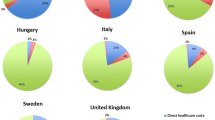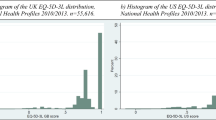Abstract
Objective
To estimate the social/economic costs of fragile X syndrome (FXS) in Europe and to assess the health-related quality of life (HRQOL) of patients and caregivers.
Methods
A cross-sectional study was conducted in a sample of European countries. Patients were recruited through patients’ associations. Data on their resource use and absence from the labour market were retrospectively obtained from an online questionnaire. Costs were estimated by a bottom-up approach and the EuroQol-5 Domain (EQ-5D) questionnaire was used to measure patients’ and caregivers’ HRQOL.
Results
Five countries were included in the analysis. The mean annual cost of FXS per patient varied from €4951 in Hungary to €58,862 in Sweden. Direct non-healthcare costs represented the majority of costs in all countries but there were differences in the share incurred by formal and informal care among those costs. Costs were also shown to differ between children and adults. Mean EQ-5D utility score for adult patients varied from 0.52 in France (n = 42) to 0.73 in Hungary (n = 2), while for caregivers this score was consistently inferior to 0.87.
Conclusion
Our findings underline that, although its prevalence is low, FXS is costly from a societal perspective. They support the development of tailored policies to reduce the consequences of FXS on both patients and their relatives.


Similar content being viewed by others
References
Bassell, G.J., Warren, S.T.: Fragile X syndrome: loss of local mRNA regulation alters synaptic development and function. Neuron 60, 201–214 (2008)
Jacquemont, S., Berry-Kravis, E., Hagerman, R., von Raison, F., Gasparini, F., Apostol, G., Ufer, M., Des Portes, V., Gomez-Mancilla, B.: The challenges of clinical trials in fragile X syndrome. Psychopharmacology (Berl.) 231, 1237–1250 (2014)
Hagerman, R., Hoem, G., Hagerman, P.: Fragile X and autism: intertwined at the molecular level leading to targeted treatments. Mol. Autism. 1, 12 (2010)
Heulens, I., Suttie, M., Postnov, A., De Clerck, N., Perrotta, C.S., Mattina, T., Faravelli, F., Forzano, F., Kooy, R.F., Hammond, P.: Craniofacial characteristics of fragile X syndrome in mouse and man. Eur. J. Hum. Genet. EJHG. 21, 816–823 (2013)
Crawford, D.C., Acuña, J.M., Sherman, S.L.: FMR1 and the fragile X syndrome: human genome epidemiology review. Genet. Med. Off. J. Am. Coll. Med. Genet. 3, 359–371 (2001)
Orphanet Report Series—Prevalence of rare diseases: http://www.orpha.net/orphacom/cahiers/docs/GB/Prevalence_of_rare_diseases_by_decreasing_prevalence_or_cases.pdf (2013). Accessed 20 Nov 2015
Song, F.J., Barton, P., Sleightholme, V., Yao, G.L., Fry-Smith, A.: Screening for fragile X syndrome: a literature review and modelling study. Health Technol. Assess. Winch. Engl. 7, 1–106 (2003)
López-Bastida, J., Oliva-Moreno, J.: Cost of illness and economic evaluation in rare diseases. Adv. Exp. Med. Biol. 686, 273–282 (2010)
Hartley, S.L., Seltzer, M.M., Raspa, M., Olmstead, M., Bishop, E., Bailey, D.B.: Exploring the adult life of men and women with fragile X syndrome: results from a national survey. Am. J. Intellect. Dev. Disabil. 116, 16–35 (2011)
Bailey Jr, D.B., Raspa, M., Bishop, E., Mitra, D., Martin, S., Wheeler, A., Sacco, P.: Health and economic consequences of fragile X syndrome for caregivers. J. Dev. Behav. Pediatr. JDBP. 33, 705–712 (2012)
Chevreul, K., Berg Brigham, K., Brunn, M., des Portes, V., BURQOL-RD Research Network: Fragile X syndrome: economic burden and health-related quality of life of patients and caregivers in France. J. Intellect. Disabil. Res. JIDR. 59(12), 1108–1120 (2015)
Lorgelly, P.K., Joshi, D., Iturriza Gómara, M., Flood, C., Hughes, C.A., Dalrymple, J., Gray, J., Mugford, M.: Infantile gastroenteritis in the community: a cost-of-illness study. Epidemiol. Infect. 136, 34–43 (2008)
Lee, T.-J., Park, B.-H., Kim, J.W., Shin, K., Lee, E.B., Song, Y.-W.: Cost-of-illness and quality of life in patients with ankylosing spondylitis at a tertiary hospital in Korea. J. Korean Med. Sci. 29, 190 (2014)
Tarricone, R.: Cost-of-illness analysis: what room in health economics? Health Policy 77, 51–63 (2006)
Drummond, M., O’Brien, B., Stoddart, G., Torrance, G.: Methods for the economic evaluation of health care programmes, 2nd edn. Oxford University Press, Oxford (1997)
McDaid, D.: Estimating the costs of informal care for people with Alzheimer’s disease: methodological and practical challenges. Int. J. Geriatr. Psychiatry 16, 400–405 (2001)
Van den Berg, B., Brouwer, W.B.F., Koopmanschap, M.A.: Economic valuation of informal care. An overview of methods and applications. Eur. J. Health Econ. 5, 36–45 (2004)
Tranmer, J.E., Guerriere, D.N., Ungar, W.J., Coyte, P.C.: Valuing patient and caregiver time: a review of the literature. PharmacoEconomics. 23, 449–459 (2005)
Hodgson, T.A., Meiners, M.R.: Cost-of-illness methodology: a guide to current practices and procedures. Milbank Mem. Fund Q. Health Soc. 60(3), 429–462 (1982)
Brooks, R.: EuroQol: the current state of play. Health Policy Amst. Neth. 37, 53–72 (1996)
Dolan, P.: Modeling valuations for EuroQol health states. Med. Care 35, 1095–1108 (1997)
Van Steensel, F.J.A., Bögels, S.M., Dirksen, C.D.: Anxiety and quality of life: clinically anxious children with and without autism spectrum disorders compared. J. Clin. Child Adolesc. Psychol. Off. J. Soc. Clin. Child Adolesc. Psychol. Am. Psychol. Assoc. Div. 53(41), 731–738 (2012)
Khanna, R., Jariwala, K., Bentley, J.P.: Health utility assessment using EQ-5D among caregivers of children with autism. Value Health J. Int. Soc. Pharmacoecon. Outcomes Res. 16, 778–788 (2013)
EuroQol—EQ-5D-Y. http://www.euroqol.org/eq-5d-products/eq-5d-y.html. Accessed 20 Nov 2015
Pickard, A.S., Johnson, J.A., Feeny, D.H., Shuaib, A., Carriere, K.C., Nasser, A.M.: Agreement between patient and proxy assessments of health-related quality of life after stroke using the EQ-5D and health utilities index. Stroke 35, 607–612 (2004)
Diaz-Redondo, A., Rodriguez-Blazquez, C., Ayala, A., Martinez-Martin, P., Forjaz, M.J., Spanish Research Group on Quality of Life and Aging: EQ-5D rated by proxy in institutionalized older adults with dementia: Psychometric pros and cons. Geriatr. Gerontol. Int. (2013) (Epub ahead of print)
Balboni, G., Coscarelli, A., Giunti, G., Schalock, R.L.: The assessment of the quality of life of adults with intellectual disability: the use of self-report and report of others assessment strategies. Res. Dev. Disabil. 34, 4248–4254 (2013)
Mahoney, F.I., Barthel, D.W.: Functional evaluation: the Barthel index. Md. State Med. J. 14, 61–65 (1965)
Shah, S., Vanclay, F., Cooper, B.: Improving the sensitivity of the Barthel index for stroke rehabilitation. J. Clin. Epidemiol. 42, 703–709 (1989)
Lewis, C., Shaw, K.: The (Original) Barthel Index of ADLs. Phys. Ther. Rehab Med. (2006)
Hébert, R., Bravo, G., Préville, M.: Reliability, validity and reference values of the Zarit Burden Interview for assessing informal caregivers of community-dwelling older persons with dementia. Can. J. Aging. 19, 494–507 (2000)
The World Bank: GDP per capita (current US$)|Data|Table, http://data.worldbank.org/indicator/NY.GDP.PCAP.CD
Reher, D.S.: Family ties in Western Europe: persistent Contrasts. Popul. Dev. Rev. 24, 203 (1998)
Vilaplana Prieto, C., Jiménez-Martín, S., García Gómez, P.: Trade-off between formal and informal care in Europe. Gac. Sanit. SESPAS 25(Suppl 2), 115–124 (2011)
PIB par habitant ($ US courants) | Données | Tableau, http://donnees.banquemondiale.org/indicateur/NY.GDP.PCAP.CD
Grobon, S.: Les ménages aisés envisageraient plus souvent de déléguer la prise en charge de leur proche parent dépendant. (2014)
Wildhagen, M.F., van Os, T.A., Polder, J.J., ten Kate, L.P., Habbema, J.D.: Explorative study of costs, effects and savings of screening for female fragile X premutation and full mutation carriers in the general population. Community Genet. 1, 36–47 (1998)
Prices and purchasing power parities (PPP)—Organisation for Economic Co-operation and Development. http://www.oecd.org/std/prices-ppp/eurostat-oecdmethodologicalmanualonpurchasingpowerparitiesppps.htm
Shemilt, I., Thomas, J., Morciano, M.: A web-based tool for adjusting costs to a specific target currency and price year. Evid. Policy J. Res. Debate Pract. 6, 51–59 (2010)
Life expectancy at birth, male (years)|Data|Table, http://data.worldbank.org/indicator/SP.DYN.LE00.MA.IN/countries
Life expectancy at birth, female (years)|Data|Table, http://data.worldbank.org/indicator/SP.DYN.LE00.FE.IN/countries
Musci, T.J., Caughey, A.B.: Cost-effectiveness analysis of prenatal population-based fragile X carrier screening. Am. J. Obstet. Gynecol. 192, 1905–1912 (2005)
Coppus, A.M.W.: People with intellectual disability: what do we know about adulthood and life expectancy? Dev. Disabil. Res. Rev. 18, 6–16 (2013)
Doran, C.M., Einfeld, S.L., Madden, R.H., Otim, M., Horstead, S.K., Ellis, L.A., Emerson, E.: How much does intellectual disability really cost? First estimates for Australia. J. Intellect. Dev. Disabil. 37, 42–49 (2012)
Chevalier, J., de Pouvourville, G.: Valuing EQ-5D using time trade-off in France. Eur. J. Health Econ. HEPAC Health Econ. Prev. Care. 14, 57–66 (2013)
Szende, A., Németh, R.: Health-related quality of life of the Hungarian population. Orv. Hetil. 144, 1667–1674 (2003)
Scalone, L., Cortesi, P.A., Ciampichini, R., Belisari, A., D’Angiolella, L.S., Cesana, G., Mantovani, L.G.: Italian population-based values of EQ-5D health States. Value Health. 16, 814–822 (2013)
Venturini, A., Giannini, B., Montefiori, M., Di Biagio, A., Mazzarello, G., Cenderello, G., Giacomini, M., Merlano, C., Orcamo, P., Setti, M., Viscoli, C., Cassola, G.: Quality of life of people living with HIV, preliminary results from IANUA (Investigation on Antiretroviral Therapy) study. J. Int. AIDS Soc. 17, 19581 (2014)
Lopez-Bastida, J., Oliva-Moreno, J., Perestelo-Perez, L., Serrano-Aguilar, P.: The economic costs and health-related quality of life of people with HIV/AIDS in the Canary Islands, Spain. BMC Health Serv. Res. 9, 55 (2009)
Burström, K., Johannesson, M., Diderichsen, F.: Swedish population health-related quality of life results using the EQ-5D. Qual. Life Res. Int. J. Qual. Life Asp. Treat. Care Rehabil. 10, 621–635 (2001)
Khanna, R., Jariwala, K., Bentley, J.P.: Health utility assessment using EQ-5D among caregivers of children with autism. Value Health. 16, 778–788 (2013)
Canonici, A.P., de Andrade, L.P., Gobbi, S., Santos-Galduroz, R.F., Gobbi, L.T.B., Stella, F.: Functional dependence and caregiver burden in Alzheimer’s disease: a controlled trial on the benefits of motor intervention. Psychogeriatrics. 12, 186–192 (2012)
Yatsugi, S., Suzukamo, Y., Izumi, S.: Productive social activities in mothers of intellectually disabled children moderate the relationship between caregiver burden and self-rated health. Jpn. J. Public Health. 60, 387–395 (2013)
Bourgeois, J.A., Seritan, A.L., Casillas, E.M., Hessl, D., Schneider, A., Yang, Y., Kaur, I., Cogswell, J.B., Nguyen, D.V., Hagerman, R.J.: Lifetime prevalence of mood and anxiety disorders in fragile X premutation carriers. J. Clin. Psychiatry 72, 175–182 (2011)
Roberts, J.E., Bailey Jr, D.B., Mankowski, J., Ford, A., Sideris, J., Weisenfeld, L.A., Heath, T.M., Golden, R.N.: Mood and anxiety disorders in females with the FMR1 premutation. Am. J. Med. Genet. B Neuropsychiatr. Genet. 150B, 130–139 (2009)
Lubeck, D.P.: The costs of musculoskeletal disease: health needs assessment and health economics. Best Pract. Res. Clin. Rheumatol. 17, 529–539 (2003)
Landfeldt, E., Lindgren, P., Bell, C.F., Schmitt, C., Guglieri, M., Straub, V., Lochmüller, H., Bushby, K.: The burden of Duchenne muscular dystrophy: an international, cross-sectional study. Neurology. 83(6), 529–536 (2014)
Acknowledgments
The authors wish to thank the National Alliance of People with Rare Diseases (NAPRD), Bulgaria; Alliance Maladies Rares, France; ACHSE, Germany; Hungarian Federation of People with Rare and Congenital Diseases (RIROSZ), Hungary; Federazione Italiana Malattie Rare (UNIAMO), Italy; Associazione Italiana Sindrome X Fragile, Italy; the Consulta Nazionale delle Malattie Rare, Italy; Rare Diseases Sweden; Federación Española de Efermedades Raras (FEDER), Spain; Rare Disease UK; and Rare Diseases Europe (EURORDIS); Mosaiques, Association Le Goeland X-Fragile, France; Martin-Bell Baráti Közösség, Hungary; Associazione Italiana Sindrome X Fragile, Italy; Federación Española del Síndrome de X Frágil, Asociación para la integración de personas afectadas por X-Frágil u otro TGD en Andalucía, Asociación del Síndrome X-Frágil de Madrid, Extremadura y Cataluña, Spain.
Author information
Authors and Affiliations
Consortia
Corresponding author
Ethics declarations
Funding
Supported by the Social/Economic Burden and Health-Related Quality of Life in Patients with Rare Diseases in Europe Project, which has received funding from the European Union within the framework of the Health Programme (Grant A101205). The Executive Agency of the European Union is not responsible for any use that may be made of the information contained herein.
Conflict of interest
The authors declare that they have no conflicts of interest.
Additional information
Members of the BURQOL-RD Research Network listed in the Supplementary Annex 1.
Electronic supplementary material
Below is the link to the electronic supplementary material.
Rights and permissions
About this article
Cite this article
Chevreul, K., Gandré, C., Brigham, K.B. et al. Social/economic costs and health-related quality of life in patients with fragile X syndrome in Europe. Eur J Health Econ 17 (Suppl 1), 43–52 (2016). https://doi.org/10.1007/s10198-016-0784-3
Received:
Accepted:
Published:
Issue Date:
DOI: https://doi.org/10.1007/s10198-016-0784-3




